
Cleaner shrimp is a common name for a number of swimming decapod crustaceans that clean other organisms of parasites. Most are found in the families Hippolytidae and Palaemonidae, though the families Alpheidae, Pandalidae, and Stenopodidae each contain at least one species of cleaner shrimp. The term "cleaner shrimp" is sometimes used more specifically for the family Hippolytidae and the genus Lysmata.

Acetes is a genus of small shrimp that resemble krill, which is native to the western and central Indo-Pacific, the Atlantic coast of the Americas, Pacific coast of South America and inland waters of South America. Although most are from marine or estuarine habitats, the South American A. paraguayensis is a fresh water species. Several of its species are important for the production of shrimp paste in Southeast Asia, including A. japonicus, which is the world's most heavily fished species of wild shrimp or prawn in terms of total tonnage and represent the majority of non-human animals killed for food in terms of number of individuals.

Palaemon is a genus of caridean shrimp in the family Palaemonidae.

Palaemon affinis is a species of shrimp of the family Palaemonidae. Early authors used the name Palaemon affinis for specimens now known to belong to a variety of species, but P. affinis is now known to be endemic to the waters of New Zealand.
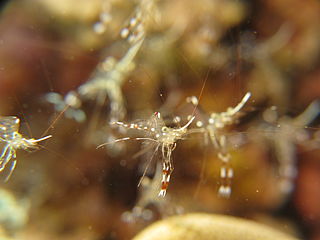
Urocaridella antonbruunii, common names clear cleaner shrimp or red-white cleaner shrimp, is a species of shrimp belonging to the family Palaemonidae. It was described by A. J. Bruce in 1967. It is one of the species that are known as cleaner shrimps.

Palaemon adspersus, commonly called Baltic prawn, is a species of shrimp that is frequent in the Baltic Sea, and is the subject of fisheries in Denmark. It is up to 70 mm (2.8 in) long, and lives in Zostera beds.

Pandalus montagui is a species of cold-water shrimp in the family Pandalidae. It is the type species of the genus Pandalus and is variously known as the pink shrimp, Aesop shrimp and Aesop prawn.

Trachysalambria curvirostris is a species of prawn that lives in shallow waters of the Indo-West Pacific. It is one of the most important species targeted by prawn fishery, with annual harvests of more than 300,000 t, mostly landed in China.

A shrimp (pl.: shrimp or shrimps is a crustacean with an elongated body and a primarily swimming mode of locomotion – typically belonging to the Caridea or Dendrobranchiata of the order Decapoda, although some crustaceans outside of this order are also referred to as "shrimp".
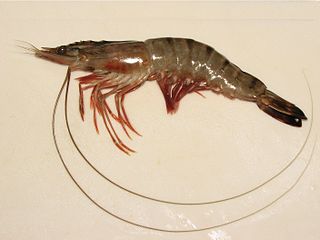
Prawn is a common name for small aquatic crustaceans with an exoskeleton and ten legs, some of which are edible.

Palaemon pugio, commonly known as daggerblade grass shrimp, is a small, transparent species of shrimp with yellow coloring and brownish spots. It can be found in estuarine and tidal marsh habitats throughout the western Atlantic Ocean and Gulf of Mexico. Palaemon pugio has a smooth carapace and abdomen, as well as three pairs of legs. The second pair is the strongest, while the third pair lacks chelae (claws). It reaches a length of around 5 cm (2.0 in), and has a life span of around one year. Like most grass shrimp, it is a forager and feeds on a variety of items, including microalgae. They themselves are consumed by killifish and other small foraging fish.
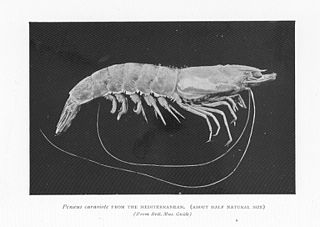
Melicertus kerathurus, the striped prawn or caramote prawn is a species of tiger prawn from the family Penaeidae which occurs in the eastern Atlantic and Mediterranean Sea which is an important species in commercial fisheries. It is the type species for the genus Melicertus.
Macrobrachium vollenhoveni, the African river prawn, is a species of large, commercially important prawn from the family Palaemonidae from West Africa. It is a catadromous species that moves from freshwater to brackish water to spawn returning to freshwater as larvae. Recent research has shown that it could potentially be used as a biological control to reduce the rates of infection people living near rivers where this species occurs with schistosomiasis.

Palaemon pandaliformis is a species of shrimp of the family Palaemonidae. It is found along with Palaemon northropi.
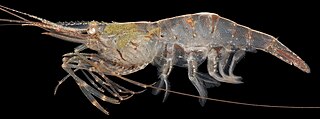
Palaemon macrodactylus is a species of shrimp of the family Palaemonidae.

Feeder shrimp, ghost shrimp, glass shrimp, grass shrimp, river shrimp or feeder prawns are generic names applied to inexpensive small, typically with a length of 1 to 3 cm, semi-transparent crustaceans commonly sold and fed as live prey to larger more aggressive fishes kept in aquariums.

Palaemon modestus, the Siberian prawn, is a species of freshwater shrimp from eastern Asia. A revision to Palaemon in 2013 moved Palaemon modestus to the Palaemon genus from the Exopalaemon genus.

Macrobrachium nobilii is a species of freshwater shrimp, first described by Henderson and Matthai, 1910. It belongs to the order Decapoda and family Palaemonidae.
Processa edulis is a species of caridean shrimp found in shallow water in the Atlantic Ocean and the Mediterranean Sea. It mostly inhabits seagrass beds and eelgrass flats, hiding by day and feeding at night. A common name for it is nika shrimp.
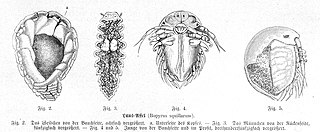
Bopyrus squillarum is an isopod parasite of the infraorder Epicaridea. As such, B. squillarum is an ectoparasite, feeding off crustaceans hemolymph. This parasite is specific to common prawns, but can rarely be found on other species of the genus Palaemon such as P. elegans.


















